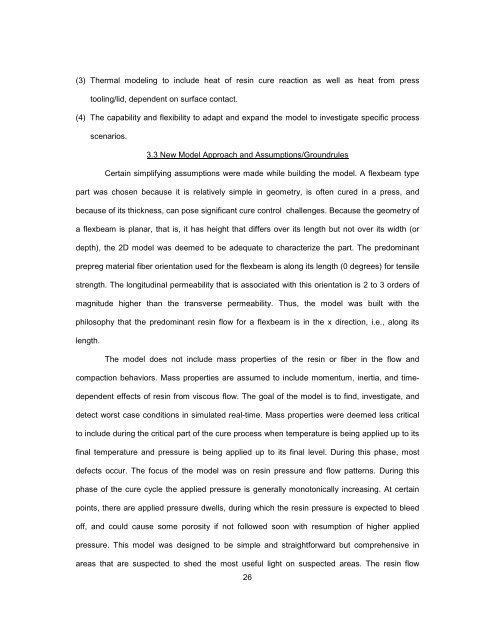TOOLED THICK COMPOSITES by ARVEN H. SAUNDERS III ...
TOOLED THICK COMPOSITES by ARVEN H. SAUNDERS III ...
TOOLED THICK COMPOSITES by ARVEN H. SAUNDERS III ...
You also want an ePaper? Increase the reach of your titles
YUMPU automatically turns print PDFs into web optimized ePapers that Google loves.
(3) Thermal modeling to include heat of resin cure reaction as well as heat from press<br />
tooling/lid, dependent on surface contact.<br />
(4) The capability and flexibility to adapt and expand the model to investigate specific process<br />
scenarios.<br />
3.3 New Model Approach and Assumptions/Groundrules<br />
Certain simplifying assumptions were made while building the model. A flexbeam type<br />
part was chosen because it is relatively simple in geometry, is often cured in a press, and<br />
because of its thickness, can pose significant cure control challenges. Because the geometry of<br />
a flexbeam is planar, that is, it has height that differs over its length but not over its width (or<br />
depth), the 2D model was deemed to be adequate to characterize the part. The predominant<br />
prepreg material fiber orientation used for the flexbeam is along its length (0 degrees) for tensile<br />
strength. The longitudinal permeability that is associated with this orientation is 2 to 3 orders of<br />
magnitude higher than the transverse permeability. Thus, the model was built with the<br />
philosophy that the predominant resin flow for a flexbeam is in the x direction, i.e., along its<br />
length.<br />
The model does not include mass properties of the resin or fiber in the flow and<br />
compaction behaviors. Mass properties are assumed to include momentum, inertia, and time-<br />
dependent effects of resin from viscous flow. The goal of the model is to find, investigate, and<br />
detect worst case conditions in simulated real-time. Mass properties were deemed less critical<br />
to include during the critical part of the cure process when temperature is being applied up to its<br />
final temperature and pressure is being applied up to its final level. During this phase, most<br />
defects occur. The focus of the model was on resin pressure and flow patterns. During this<br />
phase of the cure cycle the applied pressure is generally monotonically increasing. At certain<br />
points, there are applied pressure dwells, during which the resin pressure is expected to bleed<br />
off, and could cause some porosity if not followed soon with resumption of higher applied<br />
pressure. This model was designed to be simple and straightforward but comprehensive in<br />
areas that are suspected to shed the most useful light on suspected areas. The resin flow<br />
26
















